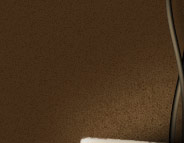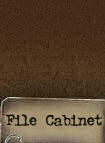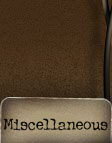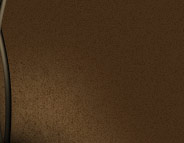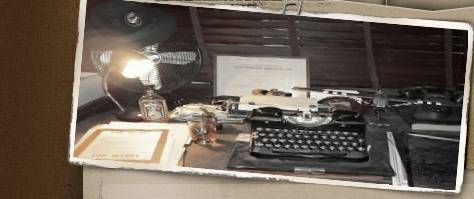
File No.:
Case File # 21
Title: "The Mysterious
Wolfheze Railway Station Girl"
Subject:
Identifying the "particularly
pretty girl attracting a lot of
attention"
which Martin
Middlebrook mentioned in his
1994 book "Arnhem 1944 the
Airborne Battle"
Investigation made at:
Wolfheze, the Netherlands
GPS Location:
52°00'19.8"N 5°47'31.6"E
Period Covered:
17-20SEP1944
Date: 14JUN2025
Case Classification:
Battlefield myth
Status of Case: Unsolved
|
|
Introduction:
In his book "Arnhem 1944 the
Airborne Battle", Penguin
Books 1994 ISBN 0-14-014342-4,
Martin Middlebrook wrote in
Chapter 8 "The Vital Hours"
on page 117:
"The
little railway station at
Wolfheze became a center of
activity, with many airborne men
arriving there from the landing
area. One particularly pretty
girl – believed at the time to
be the daughter of the station
master, though this was not so –
attracted a lot of attention,
including those of ‘a
ginger-haired war
correspondent’."
Who
could have been that girl that
distracted not only a war
correspondent embedded with the
British 1st Airborne Division,
but also at least some airborne
soldiers with an operational
task at hand?
This agency
looked into it. |
(click to enlarge)

_small.jpg)
_small.jpg)
_small.jpg)

Fig.:
Wolfheze Railway Station today.
The station design is of the
“Visvliet” type that was used from
1890 to 1903 for a total of six
railway stations in the Netherlands.
In 1899 the station building in
Wolfheze was opened. The building in
Wolfheze is the last of these six
still standing and hasn’t changed
much over the years. |
REASON FOR INVESTIGATION:
The
story of an unmistakably
beautiful girl keeping British
paratroopers and glider soldiers
from doing their jobs because
her looks distract them, speaks
to the imagination of a few
members of this agency. The fact
that the scene took place on a
railway station passed-by
regularly, by us commuting to
work, fueled a desire to try and
answer the question who this
girl may have been. |
Spoiler alert
We
must warn the reader at this stage ,
that on the day of (the initial) publication of
this case file, the riddle has NOT
been solved and it is still an
ongoing investigation. The reason
for publication however, is to share
our methods of investigation, give
insights in our trains of thought,
explain how battle detectives
develop hypotheses and use deduction
to eliminate unlikely or impossible
scenarios.
SYNOPSIS:
Author Martin Middlebrook has not
mentioned the source for the Railway
Station Girl story. He boldly stated
that rumor may have had it that the
girl was the daughter of the station
master but that this is untrue. He
also mentioned the charming effect
that the girl had on a person who
could be identified without much
effort. Although Middlebrook did use
a handful of footnotes in "Arnhem
1944", there are none explaining the
origin of the information for this
paragraph.
Gripped by the
thought of identifying the
particularly pretty girl, we
therefor had to start from the text
of the story.
|
Railway Station Master
of Wolfheze
From
a website about the history of
railway stations in the
Netherlands we learned that
until 9 JUN1942, an Albertus
Nicolaas Zeldenrust was station
master of Wolfheze. His career
apparently ended on that date.
He was 55 years old at the time.
It was not until 1DEC1949 that a
new station master named Hendrik
Hattuma arrived, who was then 52
years old.
In the section
Wolfheze of the telephone
directory of 1943, the telephone
number of the Station is listed
under Dutch Railways: 224.
In
the daily reports of the
Municipal Police Oosterbeek, it
is noted on 17SEP1944 that at
"12.20
De Ruiter, acting station master
at Wolfheze, reports bomb attack
at Wolfheze station (direct
hit), four houses hit by direct
hits, everything rubble and
dust, people are still in air
raid shelters."
|
(click to enlarge)
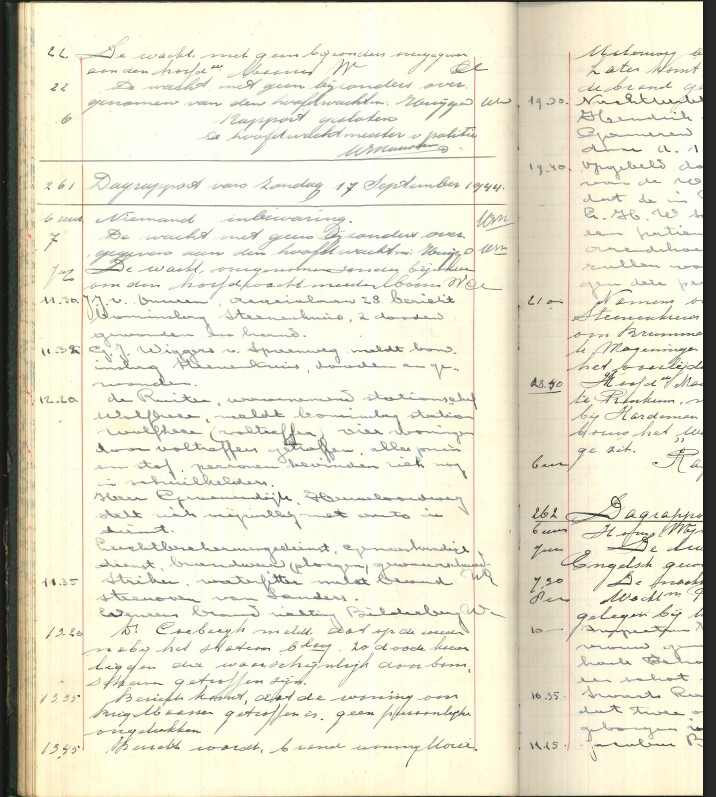

Fig. Left: The
original page of 17SEP1944 from
the Municipal Police of Renkum
report book,
kept in the
Gelders Archief in Arnhem;
retrieved 26JUN2025);
Right: Detail
from the page with acting
station master De Ruiters
message.
|
(click to enlarge)



Fig.: Now&Then comparisons of damage
to buildings close to the Wolfheze
railway station as reported by
acting station master (De) Ruiter.
From top to bottom:
Top) The hotel next to the railway
station;
Center) The
Sonneheerdt building on the grounds
of the psychiatric hospital
across the road from the railway
station;
Bottom) The church on the
grounds of the psychiatric hospital |
Telephone Directory of 1943
The damage report was
almost certainly received by
telephone, otherwise it would have
said "came to report" or "came to
the station", or words to that
effect. The caller, deputy
stationmaster De Ruiter, probably
made the call from the telephone
with number 224. He could be the
same person as the "J. Ruiter
Boschb. De Ginkel" listed in the
telephone directory with number
223. |
(click to enlarge)

Fig.:
Listing of all telephone numbers in
Wolfheze in the directory of 1943. |
Remarkably enough, that is a
single number lower than the number
of the railway station.
Also the
subscriber with the number
225, an "Otterlo C.
v.", is listed as forwarder
handling orders for the Netherlands
Railways.
Municipal
Population Registry
In the
(Reconstructed) Population Register
of the Municipality of Renkum we
found that “Ruiter, G.” is listed as
follows:
Occupation:
forest worker
Date of
establishment: 10-10-1941
Address: Buunderkamp 17, Wolfheze
Municipality: Renkum
Originating
from: Ede
The Archives
When we
visited the Gelderland Regional
Archive on Friday 6JUN2025, we were
told that the population registers
of the municipalities of Renkum and
Arnhem were destroyed during World
War Two. Hence the addition of
"reconstructed" in the name of the
collection in the archive. The
register only exists in a digital
format. After the war information
was gathered from all kinds of
sources to reconstruct the
administration of residents in the
towns and villages of the
municipality of Renkum. We found
that the source of the details about
G. Ruiter originates from a
publication of changes in the
population of the municipality of
Renkum in the Arnhemsche Courant of
13OCT1941:
|
(click to enlarge)

Fig.:
Publication by the municipality of
Renkum of entry of G. Ruiter
as
a resident in Wolfheze in the
Arnhemsche Courant of Monday October
13th 1941 |
Neither the publication nor the
reconstructed population register
list G. Ruiter’s date of birth or
whether more people reside on
Buunderkamp No. 17.
Address Buunderkamp 17 in Wolfheze
The 1943 telephone directory
however, has a "Noordam, J."
with telephone number 221
listed on the address Buunderkamp
17.
From
a website about the history of the
municipality of Renkum, we
learned that Johannes Noordam was
born in Zegwaard in 1876, was the
director of the "Vereniging voor
Melkproducten en Zuivelbereiders"
(Association for Milk Products and
Dairy Processors) and that he died
at this address on 13JAN1967.
A
year later in 1968, his widow,
Vroukje Boerstra, passed
away.
|
(click to enlarge)
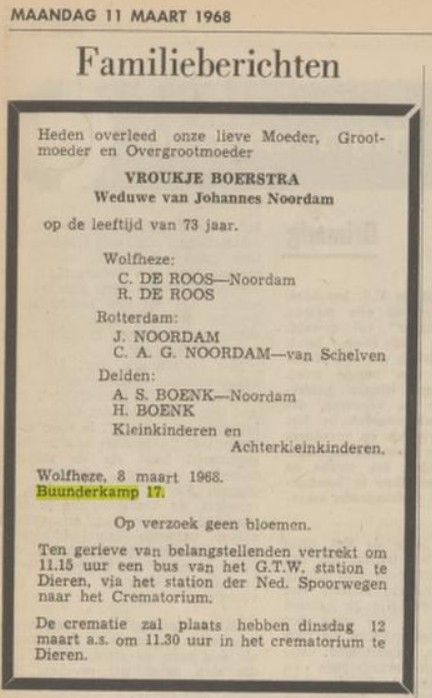
Fig.: Obituary for the widow of
Johannes Noordam in 1968 with
childres listed |
From 1968 R. de Roos
and C. de Roos - Noordam
lived in the house who had already
lived their for a stint in 1940:
C. de Roos née Noordam, profession:
none, moved in the house on
24AUG1940 and on 14SEP1940 an R. de
Roos, profession: none, left the
house.
Moreover, the website tells
us that also a G.H. Clerkx
van Keulen and a
A.F.A. de Haas lived on
Buunderkamp 17 in 1944.
Battle Detectives visited the
Buunderkamp area on 11JUN2025 to
find the house on No. 17 in a wooded
area outside of Wolfheze. It was a
remarkably large house.
It is
likely that both mr. J. Noordam, his
wife Vroukje, forest worker Ruiter
and G.H. Clerkx van Keulen and
A.F.A. de Haas lived in this same
house on 17SEP1944. |
Married couple G.H. Clerkx
van Keulen and A.F.A. de Haas
G.H. Clerkx van Keulen and
A.F.A. de Haas
announced their intention to get
married on
10JAN1944 at Oosterbeek in the
Arnhemsche Courant of
31DEC1944. The 24JAN1944
edition of the Arnhemsche Courant
mentioned their marriage.
|
(click to enlarge)
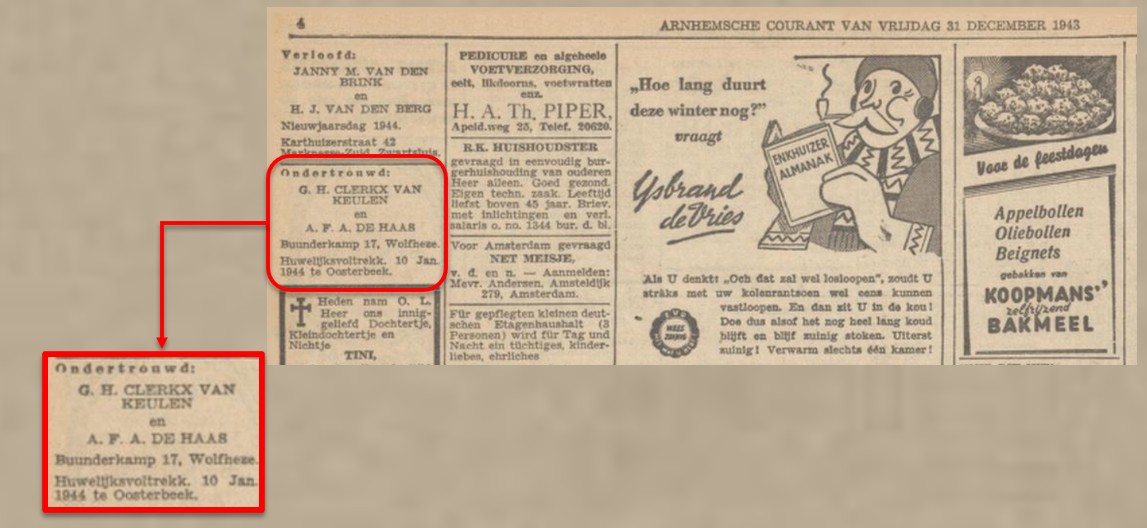
Fig.: Announcement of G.H.
Clerkx van Keulen and A.F.A. de Haas
to get
married on
10JAN1944 at Oosterbeek
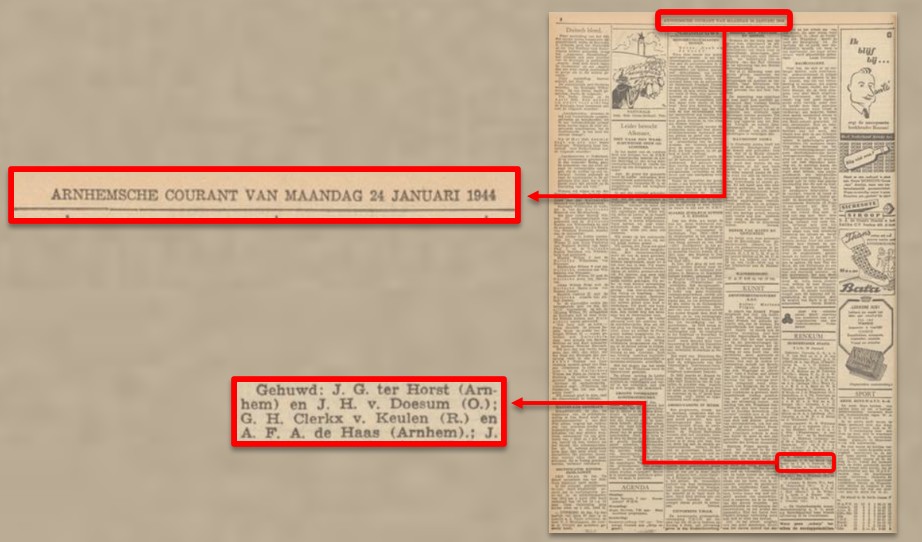
Fig.:
Publication by the municipality of
Renkum
of G.H. Clerkx van
Keulen and A.F.A. de Haas' marriage |
Hypothesis 1
Since Middlebrook wrote with
cenrtainty that the girl was
"believed at the time to be the
daughter of the station master,
though this was not so", could
it be that she did share the same
address? That would narrow it down
to A.F.A. de Haas, homeowner
Noordam's wife
Vroukje Boerstra, their daughters C.
de Roos née Noordam and A.S. Boenk
née Noordam (mentioned on the
obituary of widow Noordam in 1968)
and possibly another unknown female
resident of No. 17 Buunderkamp.
Sacked Station Master
An exciting detail is the
personnel file of the previous
station master, Albertus Nicolaas
Zeldenrust, who was transferred to
Wolfheze on 1JUN1937 to be summarily
dismissed on 10JUN1942 because of
"dishonesty". There are no details
mentioned as to the nature of the
dishonesty on this day during the
German occupation of the
Netherlands.
|
(click to enlarge)

Fig.: Wolfheze station master
Zeldenrust’s personnel file
with
in bold letters his summary
dismissal for dishonesty in 1942 |
Ginger-haired War
Correspondent
The Public
Relations team under Major R. W.
Oliver present at the Battle of
Arnhem consisted of himself, as a
Public Relations Officer, two BBC
civilian broadcasters (Stanley
Maxted and Guy Byam), two newspaper
journalists (Alan Wood of the Daily
Express and Jack Smyth of Reuters),
two censors (Captains Brett and
Williams), three men of the Army
Film and Photographic Unit
(Sergeants Mike Lewis, Dennis Smith
and Gordon Walker), and four
signallers (Butcher, Cull,
Hardcastle, and Noon).
Of these
newsmen, Jack Smyth is known to have
had red hair.
Smyth was a man of
mystery. In 1956 he wrote the book "Five
Days in Hell: The Battle of Arnhem,
1944" and was viewed rather
disdainfully by Arnhem researchers.
His book describes the fantastic
claim that he jumped into Arnhem
without any parachute training. That
Smyth actually jumped is a matter of
record as "Jack Smith War
Correspondent" is on the jump
manifests. However Martin W.
Bowman’s 2013 book "Air War
Market Garden - So Near and Yet So
Far" ISBN 9781783468881,
describes the recollections of
Lieutenant Joseph Winston "Pat"
Glover, the 10th Battalion’s
Quartermaster, who mentioned a war
correspondent asking him for a crash
course on the ins and outs of
parachute jumping!
|
(click to enlarge)
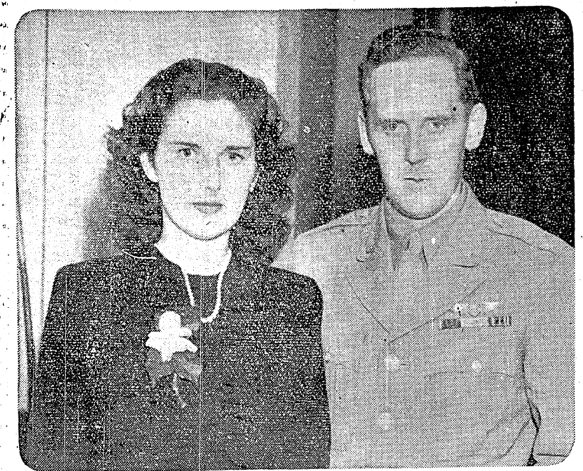
.jpg)
Fig.:
Left) Eileen Smyth and her husband Jack
Smyth photographed after World War
Two.
Right) Jack
Smyth's photo enhanced and colorized
with Artificial Intelligence |
Particularly Pretty Girl
We had good hopes that Jack Smyth’s
book would give a clue or, better
yet, a repetition of the story of
the pretty girl in Wolfheze. We
found, however, in Chapter V "The
first prisoners" on page 34 the
only story in the book involving
Wolfheze in connection to a female:
"[…] As we passed the
sanatorium, doctors, nurses and
convalescents crowded round us
cheering hysterically and clapping
us on the backs.
During the
diversionary bombing of the
surrounding woods their kitchen had
received a direct hit, they said.
But they didn’t care. The only food
they could offer us was fresh fruit
and milk. These they brought out
from the sanatorium in huge
quantities. The fruit was piled high
in wicker-baskets; the milk
overflowed from huge, earthenware
jars.
Then, one of those things
happened that can only happen to me.
I had removed my jump-helmet to wipe
the sweat from my forehead. And an
old lady spotted my red hair. She
hobbled on crutches over to me,
waving excitedly a piece of paper.
It was an Irish Hospitals Trust
Sweepstake ticket on the 1939 Grand
National. The nom-de-plume on the
back read: "Granny’s Lucky Day".
I said: “Sorry, but I’m afraid that
race is over, Grans."
"Yaw! Yaw!"
she croaked back, and everyone
howled with laughter.
Having
enjoyed our first taste of Dutch
hospitality, we pushed on through
the woods until we came to a large
clinic standing in the center of a
clearing."
|
Hypothesis 2
Because Jack Smyth was married he
may have not wanted it to be known
to the general public, and much less
to his wife, that it was he who was
so impressed by a Dutch girl that he
forgot to report on the ongoing
battle. This may have resulted in
him telling a story that may have
involved an astonishing young lady
in Wolfheze whom he changed into an
old lady on crutches.
Case Chart
We mapped our investigative leads,
discoveries and working hypotheses
in the following chart: |
(click to enlarge)

Fig.:
Chart showing leads, discoveries and
conclusions of the investigation |
CONCLUSION:
After following up on the leads
about the station master and the
girl and the subsequently developed
working hypothesis that J. Ruiter
was the acting station master, we
still have some unanswered
questions:
1) Did J. (de) Ruiter
have a daughter?
2) Why did Jack Smyth
not mention the girl?
3) Who was
the lady with the lottery ticket?
4) Who were G.H. Clerkx van Keulen
and A.F.A. de Haas who lived in the
same house on No. 17 Buunderkamp as J. Ruiter in 1944?
5) How old were the daughters of the
owner of No. 17 Buunderkamp, C. de
Roos née Noordam and A.S. Boenk née
Noordam?
6) Moreover: What was Middlebrook’s
source for his paragraph about the
girl and him stating that she wasn’t
the station master’s daughter?
The reader is encouraged to compare
notes and share any insights,
information and thoughts that could
potentially shed more light on the
mystery of the girl in Wolfheze. |
|
EXHIBITS:
To get an idea of what
the scene described by Martin
Middlebrook must have looked like,
we asked Chat GTP to recreate the
image of the pretty girl at the
railway station talking to British
soldiers and a ginger-haired war
correspondent. The software created
these images: |
(click to
enlarge)
.jpg)
.jpg)
.png)
Fig.:
Images created by Arteficial
Intelligence
|
|
UPDATE 29JUNE2025:
CASE SOLVED!
The
announcement on our
Latest News-page, and on social
media, that this Case File would be
published caused quite a stir.
Especially the fact that we used one
of the artificially generated images
to draw attention to the article
itself triggered a lot of comments
and response. Not everyone is
charmed of AI to create
illustrations. One reader advized
this agency to read the 1996 Dutch
publication "Blik Omhoog"
("Look Upward") about wartime
Wolfheze. Also, the good people of
the Wolfheze Glider Collection
reacted and invited us to visit
their exhibition today.
|
.jpg)
Fig.:
Sunday 29JUN2025 at the Wolfheze
Glider Collection from left to
right:
the owners the glider
collection, a battle detective
and the historian who tipped us
about the "Blik Omhoog" publication.
|
|
There we were shown what author Cor
Janse had written about the charming
woman at the Wolfheze railway
station:
Chapter 4.7 "IN
THE SHELTERS" […]
SHORTLIVED
LIBERATION […]
Page 739 There are
the Tommies […]
"The contacts
with the arriving Tommys were
usually limited to offering water or
fruit. With their heavy packs and
thirsty from their busy activities
on the warm Sunday, they eagerly
made use of the water that the
citizens had brought along, in zinc
tubs and enamel buckets along the
road. Fruit was offered in
abundance. In exchange, the English
gave cigarettes and chocolate.
Almost no one spoke their language,
and the people of Wolfheze were not
particularly open towards their
liberators either. They were busy
with their own tasks, although there
was some time for a chat on Monday.
* Several British soldiers remember
receiving an apple from the blond
daughters of the “stationmaster”.
The stationmaster of Wolfheze had
five daughters (Antje, Nel, Riek, Jo
and Bertha) and two sons (Rijk and
Ton). The two ladies who handed out
apples were Jo and Bertha. They were
attractive women, and soldiers
remember such things. Bertha van de
Pol (she was the blondest) was
married and had a child, but her
husband had died of tuberculosis
during the war. She later remarried
Henk Materman.
Bertha: ‘The
apples we handed out came from under
Van Dijk’s tree. I collected them in
my dress and handed them out. Van
Dijk had fled in a hurry. At
Mastbergen, father got velvet and a
roll of cloth for nightgowns. We
later exchanged that for butter.’
Ton van de Pol remembers that the
English arrived at the station and
asked if they could go upstairs,
where the family lived, to set up
machine guns. The van de Pol family
had already moved to the Buunderkamp
on Sunday, where they first found
shelter in a summer house and then
ended up in the cellar of the
Braats. Shortly before the Battle of
Arnhem, Rijk van de Pol was kicked
by a horse at Pennings, where he
worked. With a severe concussion, he
experienced the Battle in the St.
Elisabeths Gasthuis in Arnhem."
(Translated from the Dutch
language by this agency as found in:
"Blik omhoog 1940~1945 Wolfheze
en de Zuid-Veluwe in oorlogstijd",
II Tweede Boek, Cor Janse 1996,
Drukkerij Tamminga Siegers, Duiven,
ISBN 90-803567-1-9.)
One of
the owners of the Wolfheze Glider
Collections, who has lived in
Wolfheze all her life, explained
that the Wolfheze Railway girl must
have been Bertha van de Pol;
daughter of the stationmaster Van de
Pol, who lived on No. 5 Parallelweg;
the address of the railway station
and the residence of the station
master.
Unless new
information comes to light why
Martin Middelbrook in his "Arnhem
1944" published two years earlier,
stated that “though this was not
so” (not the daughter of the
station master) we feel safe to
declare this mystery as
solved.
|
(click to
enlarge)
.jpg)
Fig.: AI impression of the
situation with this new information
With the railway station in the
background
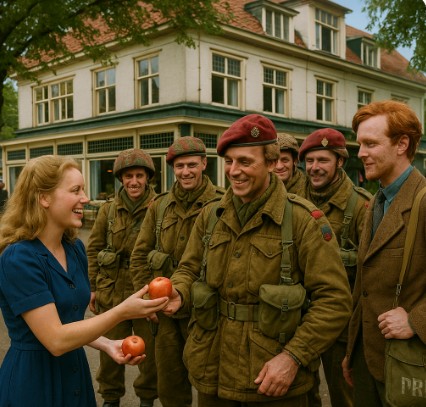
Fig.: AI impression of the situation
with this new information
With
the Hotel Van Dijk in the background
|
|
UPDATE 30JUN2025:
The
investigative lead about forest
worker De Ruiter who may have had a
part-time job at the railway
station, can be dismissed as
irrelevant.
In several sections
in the 4 volume book "Blik Omhoog"
his son Joop Ruiter described that
his family lived on Amsterdamse 75
in Ede and that his father did all
kinds of forestry work.
And on
page 522, author Janse explains who
the acting station master was who
made the call to the police on
17SEP1944:
Chapter 4.
"DISASTER" […] AID […]
Page 522
Aid from out of town
[…] "The
police station received telephoned
alert messages. From the police
report:
'(citing the message
from De Ruiter as acting station
master about bomb damage, described
here in "Railway Station
Master of Wolfheze")'.
This was probably R. de Ruijter
from the Strodorpsweg, because a De
Ruijter from Oosterbeek worked at
the Wolfheze station. We do not know
whether he called from Wolfheze or
was informed by Wolfheze station."
An explanation for the fact that
station master Van de Pol did not
make the call but his acting station
Master De Ruijter, can be found on
page 527:
"* Prüst
(police officer) and Jongboer
(administrative clerk at the police
station and fiancée of Elly Evers
from Buunderkamp) were also in the
village (on 17SEP1944 during
the bombing raid; Battle Detective
Agency).
Cees Jongboer: "I
was with my girlfriend at the time
and we strolled in the garden and we
thought it was a bombing raid on
Deelen, but a little later we saw
smoke above Wolfheze and then we got
on our bicycles and that's where we
found the disorder. I first called
the Oosterbeek station. It was not
badly damaged. The station chief
(v.d. Pol; C) was also walking
around there in a state of disarray."
|
|
It is our
theory that when the time came to
report on bomb damage in the area of
the Wolfheze railway station, Van de
Pol wasn't able to provide these
details in a telephone conversation
but railway worker De Ruiter was.
|
|
 |
|
Back to Case Files
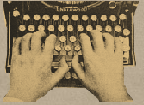 |
